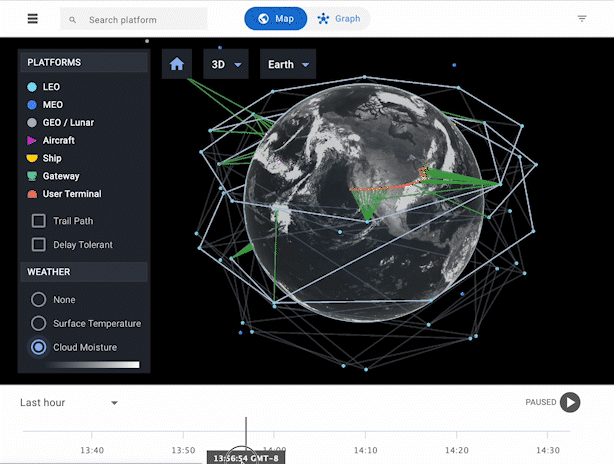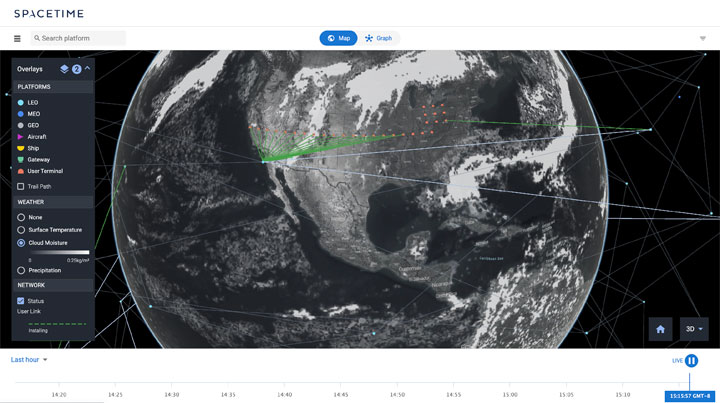COLORADO SPRINGS — Military leaders have been dreaming of a fully networked all-domain battlespace for decades. There are different reasons why the dream of connecting warfighters and assets across land, sea, air and space has remained elusive.
According to Aalyria Chief Technology Officer and Co-Founder Brian Barritt, the development of a network control plane that can orchestrate resources across domains, frequencies and orbits “is going to be one of the keys that unlocks this big vision.”
 Spacetime is designed to support land, sea, air, and space – including terrestrial terminals and handsets, ground stations, ships, aircraft, HAPS, LEO, MEO, and GEO satellite constellations, cislunar, and deep space network nodes. (Source: Aalyria)
Spacetime is designed to support land, sea, air, and space – including terrestrial terminals and handsets, ground stations, ships, aircraft, HAPS, LEO, MEO, and GEO satellite constellations, cislunar, and deep space network nodes. (Source: Aalyria)
Aalyria, the Google spinoff that came out of stealth in September 2022, recently debuted what it hopes will be the key, its software-defined networking (SDN) platform, Spacetime. During a demonstration at Satellite 2023, it simulated the loss of a LEO satellite in a multi-orbit constellation and rerouted traffic across inter-satellite links to provision a 1 Mbps data service to an aircraft. The demonstration featured a planet-scale digital twin of wireless transceivers and signal propagation to show how a multiple-hop link could be established when part of the network has been compromised, such as the loss of a satellite, submarine cable or other assets.
“We frame it as a new kind of software-defined network,” Barritt told Constellations. “We wanted to have the features found in software-defined networking and SD-WAN solutions.”
Traditionally, satcom has been concerned with solving for a limited network that generally spans a ground station antenna, a satellite and user terminal.
“That tends to be where the thinking about the problem starts and stops,” said Barritt. However, the endpoints for a satcom network flow rarely stop at the antenna. More often, a user is trying to use the connection to establish a point of presence to the internet or access enterprise resources. This demands end-to-end service orchestration that looks more like software-defined wireless telecommunications networks but also accounts for the unique characteristics of satellite communication networks.
The idea was to have a system that could understand operator requirements, like latency constraints and data rates, and solve the rest with superior visibility across multiple networks. The software is designed to essentially coordinate the provisioning of ground segment resources, space relays and payloads in various orbits, handle routing functions, radio resource management, assign channels and bandwidth frequencies across land, sea, air and space platforms. It is also designed to ingest data to adapt to contingencies, such as weather, RF interference or network congestion.
To What Endpoint?
The U.S. Department of Defense is fueling efforts to establish seamless data transport between orbits, among domains, and across military, civil and commercial providers through the Joint All-Domain Command and Control (JADC2) concept, as well as the Defense Innovation Unit’s Hybrid Space Architecture. Both programs have demanded an evolution in thinking about network architectures, vendor interoperability and how to orchestrate the flow of data between endpoints.
The lines between space and terrestrial networks are blurring, as more satellite operators and ground service providers come to view orbital assets as just another node. In a recent Constellations podcast, Clemens Kaiser, Chief Program Officer at Rivada reflected the change in thinking about satellite network management. “We are entering into a complete new way of how data will be transported in space and from any point on earth to any point on Earth,” he said. “We have an IT network in the sky, nothing else. Forget the satellites. They are routers in the sky.” Rivada Space Networks, which is building a constellation of optically interconnected LEO satellites, recently selected Aalyria to orchestrate its LEO communications constellation.
Open APIs and the Demand for Interoperability
Another hurdle the DoD has faced in making a unified all-domain network a reality has been the legacy of closed, proprietary satcom networks.
When vendors develop a satcom solution, it is typically purpose-built with a custom-built network management solution designed to optimize that network—not designed to operate with others. Within these silos, network management solutions cannot orchestrate resources across vendors and oftentimes, legacy systems struggle to integrate with the next generation. This continues to be “one of the big barriers” to creating hybrid networks and achieving the objectives of both JADC2 and the Hybrid Space Architecture, Barritt explained.
 Spacetime blends SDN and SD-WAN features for the enterprise network and ground segment with control plane orchestration of wireless networks and directional or steerable beams. (Source: Aalyria)
Spacetime blends SDN and SD-WAN features for the enterprise network and ground segment with control plane orchestration of wireless networks and directional or steerable beams. (Source: Aalyria)
It's reasonable to be skeptical of a company seeking to deploy a common network control plane. The level of integration needed to deploy that infrastructure is immense, Barritt acknowledged. “It would be a tremendous risk if a single vendor had an exclusive lock-in on that capability.” That’s where various vendors are focused on open source interfaces and cloud native applications. This not only helps mitigate the risks of vendor lock-in with cross-organization collaboration, while also drawing experience and innovation from the broader developer community.
Aalyria has released all of its open source APIs on GitHub for developers to build on and use. On one end, its APIs interface between an infrastructure resource or payload and the Spacetime platform. On the other, they interface with customer apps to enable user requests. Aalyria is also working on an API for federation between service providers, such as a gateway operator who wants to sell unused antenna capacity or a satellite operator with a space relay.
Open RAN: Satellite’s Role Beyond 5G
Parallel to government requirements for interoperability, more satcom providers are adopting standards to integrate with terrestrial telcos. 5G Release 17 established the first technical specifications for satellite integration into the 5G ecosystem. There are also growing opportunities for satcom providers, as telcos embrace Open RAN (ORAN), an architecture that leverages non-proprietary service components, open interfaces and vendor-neutral technologies to connect and manage different parts of the radio access network.
One of the factors that will help bring satellite into the fold, is the software infrastructure to support service management across increasingly complex, flexible and interoperable communications networks.
“We think the industry event that may motivate the next generation of investment in ground systems and the software involved in operating the network could very well be if the industry adopts these new non-terrestrial networking standards in 5G Advanced that are coming out in 3GPP Release 17, 18 and beyond,” Barritt said.
 Spacetime was designed to understand the physics of the Earth and space, as well as motion propagation, weather phenomena and atmospheric characteristics that affect wireless signals. It uses the position, orientation and projected motion of the physical platforms to forecast the quality and stability of upcoming connection opportunities. (Source: Aalyria)
Spacetime was designed to understand the physics of the Earth and space, as well as motion propagation, weather phenomena and atmospheric characteristics that affect wireless signals. It uses the position, orientation and projected motion of the physical platforms to forecast the quality and stability of upcoming connection opportunities. (Source: Aalyria)
Specifications for satellite and other NTN nodes are expected to figure more prominently in interim 5G releases and ultimately 6G. The evolution of these standards is one of the reasons why Aalyria is working with the Telecom Infra Project, which is home to the ORAN initiative.
Despite advances in the satellite industry leveraging 5G standards for direct-to-device (D2D) connectivity and other services, Barritt worries that too little attention has been given to network management. “Almost no work has been done, that we’ve seen, for the orchestration side of those future 5G-band satellite networks.”
Within the 5G architecture, radio resource management and orchestration are handled at a high level by the Service Management Orchestration (SMO) platform. Below that, the RAN Intelligent Control (RIC) controls radio network functions and enables the onboarding of third-party applications to automate and optimize RAN operations at scale. According to Barritt, Aalyria aims to position Spacetime as a software platform that can act as the RIC for future 5G Advanced and 6G satellite networks.
Beyond telco standards or DoD requirements, trends within the satellite industry are making the case for the adoption of common frameworks. In many ways, industry standards, open source APIs and cloud native architectures have become a hedge against the costs and risks of purpose-built network solutions.
“The satellite industry is going through a cycle of consolidation right now. There are mergers and acquisitions,” Barritt noted. “People often have multiple systems with separate platforms and they’re not able to orchestrate each other’s assets from a different vendor or a different orbital regime,” Barritt noted.
Explore More:
Podcast: Terrestrial Networks in Space, Inter-Satellite Optical Links and Free Space Optics
Is Cloud Native Make or Break for Satellite 5G?
US DoD-Forced Standards Could Save Satcom Industry from Itself
